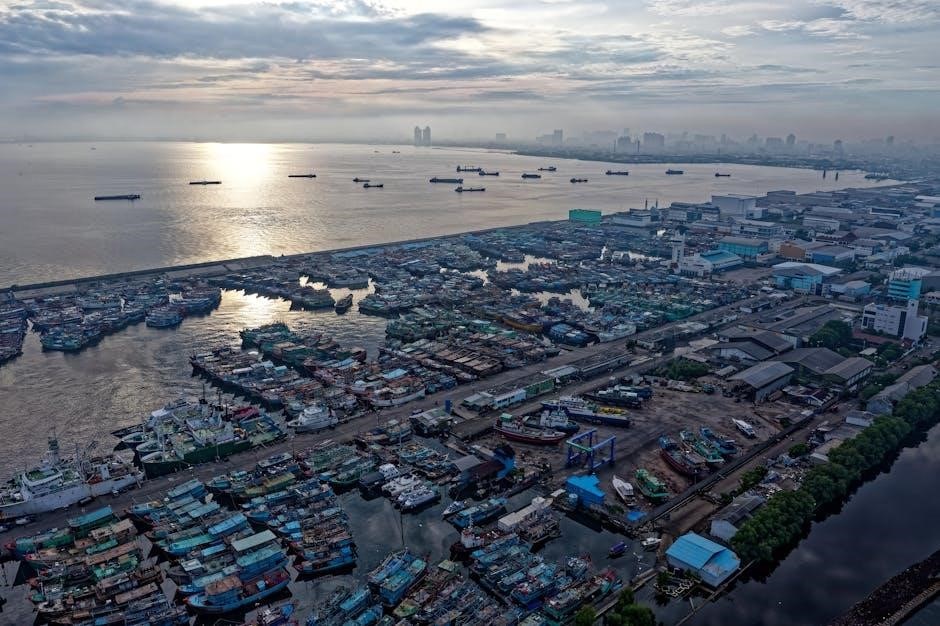Aleksandr Solzhenitsyn’s masterpiece, The Gulag Archipelago, is a gripping literary and historical investigation into the Soviet Union’s forced labor camp system, exposing its horrors and impact on millions.
Overview of the Book and Its Historical Significance
The Gulag Archipelago is a monumental work documenting the Soviet Union’s vast network of forced labor camps from 1918 to 1956. Solzhenitsyn’s masterpiece combines personal testimony, historical research, and literary craftsmanship to expose the brutal realities of the Gulag system. The book reveals the immense suffering of millions, the bureaucratic machinery of repression, and the moral resilience of survivors. First published in 1973, it shattered the veil of secrecy surrounding Stalin’s regime, becoming a pivotal text in understanding Soviet totalitarianism. Its historical significance lies in its unflinching portrayal of oppression and its enduring impact on global consciousness.
Aleksandr Solzhenitsyn and His Role as a Witness to Soviet Repression
Aleksandr Solzhenitsyn emerged as a courageous witness to Soviet repression through his personal experiences and literary works. His eight years in the Gulag, from 1945 to 1953, deeply shaped his perspective and fueled his commitment to exposing the truth. As a writer, he risked persecution to document the horrors of the Gulag, providing a voice for millions silenced by the regime. His testimony in The Gulag Archipelago not only revealed the atrocities but also became a powerful tool for dismantling the ideological foundations of Soviet totalitarianism, cementing his legacy as a moral and literary giant.
The Author: Aleksandr Solzhenitsyn
Aleksandr Solzhenitsyn was a Russian novelist, philosopher, and historian, best known for his searing depictions of life in the Soviet Gulag. His works, including The Gulag Archipelago, exposed the atrocities of the Soviet regime, earning him both acclaim and persecution. Born in 1918, Solzhenitsyn’s experiences as a Gulag prisoner deeply influenced his writing, which became a powerful critique of totalitarianism. His literary genius and moral courage continue to resonate globally, making him one of the most significant voices of the 20th century.
Biography and Personal Experience in the Gulag
Aleksandr Solzhenitsyn was born in 1918 in Kislovodsk, Russia. A decorated World War II officer, he was arrested in 1945 for criticizing Stalin in private letters. Sentenced to eight years in the Gulag, he endured harsh labor camps and internal exile. His experiences profoundly shaped his writing, particularly The Gulag Archipelago, which chronicled the brutal reality of the Soviet forced labor system. After his release in 1953 and subsequent exile, Solzhenitsyn became a vocal critic of Soviet oppression, risking persecution to reveal the truth about the Gulag and its impact on millions of lives.
Impact of His Work on Soviet and World History
Aleksandr Solzhenitsyn’s The Gulag Archipelago had a seismic impact on both Soviet and world history. Its 1973 publication exposed the atrocities of the Gulag system, shocking global audiences and undermining the Soviet Union’s legitimacy. The book became a powerful tool for human rights advocacy, inspiring dissidents within the USSR and galvanizing international opposition to communism. Solzhenitsyn’s work played a crucial role in the eventual collapse of Soviet totalitarianism, while also reshaping perceptions of freedom and oppression worldwide. His courage in confronting the regime’s crimes continues to inspire movements for justice and human dignity.

The Gulag System: Historical Context
The Gulag system emerged in the 1930s under Stalin, becoming a vast network of forced labor camps aimed at suppressing political dissent and exploiting prisoners for economic gain.
Origins and Development of the Soviet Forced Labor Camps
The Soviet forced labor camp system, known as the Gulag, originated in the 1930s under Stalin’s regime. Initially, it aimed to isolate political enemies but soon expanded to exploit prisoners for economic purposes. The Gulag grew rapidly during the Great Terror of the 1930s, with millions detained for perceived disloyalty. By the 1940s, it became a vast network of camps across Siberia and Central Asia, characterized by harsh conditions and forced labor. The NKVD, the Soviet secret police, managed the system, which peaked in size during the late 1940s before declining after Stalin’s death in 1953.
Life Inside the Gulag: Conditions, Labor, and Survival
Life within the Gulag was marked by extreme hardship and brutality. Prisoners endured overcrowded barracks, inadequate food, and insufficient clothing, often leading to malnutrition and disease. Forced labor, sometimes in freezing temperatures, was mandatory, with prisoners working long hours in dangerous conditions. Survival depended on resourcefulness, resilience, and luck. Many prisoners formed informal networks for support, while others resorted to moral compromise to survive. The psychological toll was immense, with constant fear of punishment and death. Despite these conditions, acts of resistance and solidarity were common, as prisoners sought to retain their humanity in a dehumanizing environment.
Structure and Content of “The Gulag Archipelago”
Solzhenitsyn’s work is structured as a literary investigation, blending personal narratives, historical analysis, and testimonies to reveal the Gulag’s vast, oppressive system and its profound human toll.
The Book as a Literary and Historical Investigation
The Gulag Archipelago is a monumental work that combines meticulous historical research with personal testimonies, crafting a vivid narrative of the Soviet forced labor camps.
Key Themes: Suffering, Resistance, and Moral Courage
The Gulag Archipelago delves into the profound themes of human suffering, the resilience of resistance, and the triumph of moral courage. Solzhenitsyn vividly portrays the physical and emotional torment endured by prisoners, while also highlighting their acts of defiance and survival. Through personal accounts, he illustrates how individuals maintained their dignity and humanity in the face of immense oppression. The book underscores the moral courage of those who risked everything to resist the system, offering a powerful exploration of the human spirit’s capacity for resilience and ethical steadfastness in the darkest of times.

Publication and Reception
The Gulag Archipelago, published in Paris in 1973, shocked the world with its exposé of Soviet labor camps, leading to Solzhenitsyn’s expulsion and international acclaim.

The 1973 Paris Publication and Its Global Impact
The publication of The Gulag Archipelago in Paris in 1973 marked a pivotal moment in world history. Smuggled out of the Soviet Union, the book revealed the brutal reality of the Gulag system, shocking global audiences. Its release led to Aleksandr Solzhenitsyn’s expulsion from the USSR, cementing his status as a dissident. The book’s vivid accounts of oppression and resilience sparked widespread outrage, challenging the Soviet regime’s legitimacy. Translated into multiple languages, it became a symbol of resistance against totalitarianism, inspiring human rights movements worldwide and leaving an indelible mark on historical consciousness.
Censorship and Controversy in the Soviet Union
The Gulag Archipelago faced severe censorship in the Soviet Union, banned for its unflinching portrayal of Stalinist atrocities. The regime viewed the book as a direct threat, leading to Solzhenitsyn’s persecution. Despite this, underground copies circulated, fueling dissent among intellectuals and ordinary citizens. The book’s revelations embarrassed the Soviet government internationally, intensifying its efforts to suppress the text. However, its message endured, becoming a powerful symbol of resistance against state oppression and a testament to the enduring power of truth in the face of censorship.

Legacy of “The Gulag Archipelago”
The Gulag Archipelago remains a landmark work exposing Soviet repression, inspiring global human rights advocacy, and cementing Solzhenitsyn’s legacy as a literary and moral giant.
Modern Relevance and Continued Study of the Book
The Gulag Archipelago retains profound relevance today, offering insights into authoritarianism and human resilience. Its detailed account of Soviet repression continues to educate scholars and the public alike, serving as a crucial historical resource. The book’s themes of oppression, survival, and moral courage resonate universally, making it a timeless work of historical and literary significance. Its study remains essential for understanding the darker aspects of the 20th century and the enduring struggle for human rights. Even decades after its publication, Solzhenitsyn’s masterpiece preserves the memories of millions, inspiring reflection and activism worldwide.
Solzhenitsyn’s Legacy in Literature and Human Rights Advocacy
Aleksandr Solzhenitsyn’s The Gulag Archipelago cemented his legacy as a literary giant and a fearless advocate for human rights. His work exposed the atrocities of the Soviet regime, inspiring global awareness and condemnation. Through his writing, Solzhenitsyn became a symbol of resistance against oppression, influencing countless authors and activists. His commitment to truth and justice continues to resonate, making him a pivotal figure in both literature and the fight for human dignity. Solzhenitsyn’s legacy endures, reminding the world of the power of words to challenge tyranny and uphold freedom.








































































